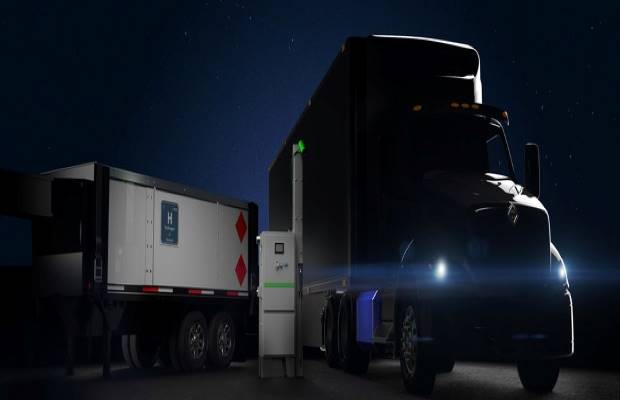Navistar Inc. has announced that it has partnered with General Motors and OneH2 to launch a complete solution for a zero-emission long-haul, hydrogen trucks system.
Navistar states it will produce its first production model of the International RHTM Series of fuel cell electric vehicles (FCE) by 2024. Testing of the vehicles is expected to start by the end of 2022. The integrated solution has a target range of 500-plus miles and a hydrogen fueling time of fewer than 15 minutes.
Describing their new production, the President & CEO of Navistar, Persio Lisboa expressed, “Hydrogen fuel cells offer great promise for heavy-duty trucks in applications requiring a higher density of energy, fast refueling, and additional range.”
“We are excited to provide customers with added flexibility through a new hydrogen truck ecosystem that combines our vehicles with the hydrogen fuel cell technology of General Motors and the modular, mobile, and scalable hydrogen production and fueling capabilities of OneH2. And we are very pleased that our valued customer J.B. Hunt has committed to utilize the solution on dedicated routes and to share key learnings,” he added.
As the company affirms, the International RHTM Series FCEV will get its energy from two GM Hydrotec fuel cell power cubes. Each Hydrotec power cube contains 300-plus hydrogen fuel cells along with thermal and power management systems.
The combined propulsion system within the International RHTM Series FCEV will feature better power density for short-range travel, better short-burst kW output.
“GM’s vision of a world with zero emissions isn’t limited to passenger vehicles. We believe in EVs for everyone,” said Doug Parks, GM executive vice president of Global Product Development, Purchasing, and Supply Chain.
Parkes further added, “We’re thrilled to work with like-minded companies like Navistar and OneH2 to offer a complete solution for progressive carriers that want to eliminate tailpipe emissions with a power solution that can compete with diesel.”
Following the agreement with Navistar, OneH2 will supply its hydrogen fueling solution, which includes hydrogen production, storage, delivery, and safety. Additionally, Navistar is taking a minority stake in OneH2.
Accordingly, OneH2 plans to kick start substantial hydrogen heavy truck refueling infrastructure by integrating more than 2,000 International® RH™ Series FCEVs into current truck fleets in the coming term.
Speaking of the partnership, the President & CEO of OneH2, Paul Dawson stated, “We’re excited about the opportunity to partner with Navistar. We believe strongly that hydrogen fuel is the future of zero-emission renewable energy in the heavy zero-emissions are pleased that this agreement will provide additional scope for its application.”
“Under this agreement, we will be able to offer fleets a zero-emission truck with a total cost of operation lower than diesel in key segments of the industry.”
Navistar International Corporation is a holding company whose subsidiaries and affiliates produce commercial trucks, proprietary diesel engines, and IC Bus for schools and commercial buses.
While General Motors focuses on an all-electric future that is inclusive and accessible to all. However, OneH2 is an integrated hydrogen fuel company.
These technologies leverage Navistar’s battery electric vehicle platforms and provide the customer with a single-source, fully integrated zero-emission solution that includes vehicles, fueling, and service.
The hydrogen truck system will be primarily piloted by J.B. Hunt Transport, Inc., a subsidiary of J.B. Hunt Transport Services, Inc. The president & CEO of J.B. Hunt mentioned, “As we serve our customers and communities, the combination of hydrogen fuel cell technology and refueling capability will enable us to reduce emissions along with energy consumption, fulfilling our environmental sustainability commitment to our customers and the communities we serve. We are excited for the potential of this innovative business model and look forward to sharing our learnings from this pilot program with Navistar and its involved technical and infrastructure partners.”

